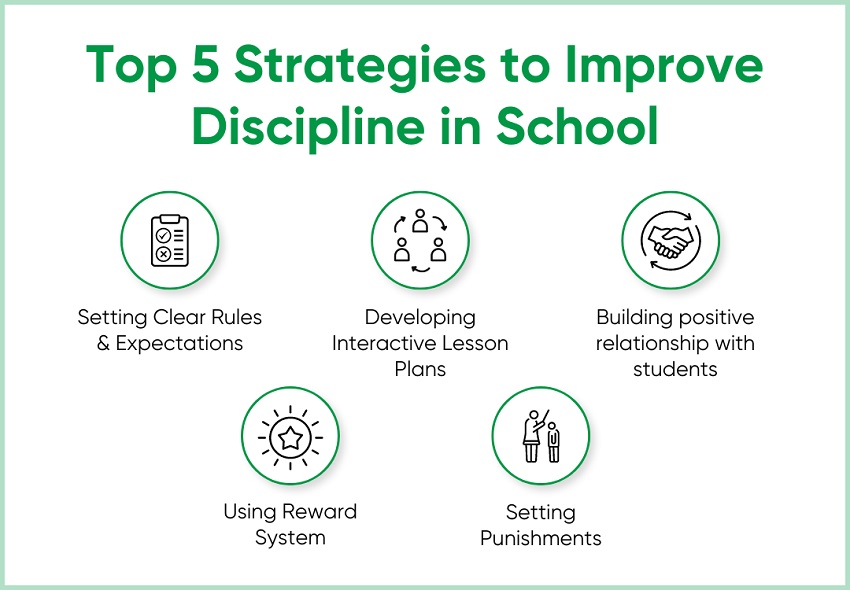Discipline in school is the foundation for creating a conducive learning environment where students can thrive both academically and socially. It helps instill respect, responsibility, and self-control among students. However, implementing discipline effectively can be a challenge for educators and administrators. When done right, it leads to fewer disruptions, improved student behavior, and better academic outcomes.
In this blog, we’ll explore why discipline is essential, the different approaches schools can take, and actionable steps to maintain discipline in classrooms.
Why Discipline is Essential in School
Discipline is more than enforcing rules; it’s about fostering a positive culture where students feel safe and motivated to learn. Without discipline, classrooms can become chaotic, affecting the learning process and overall school atmosphere. Here’s why discipline is vital:
- Promotes a Positive Learning Environment
When students understand and follow rules, teachers can focus on teaching, and students can focus on learning without unnecessary distractions. - Teaches Responsibility and Self-Control
Discipline helps students take responsibility for their actions, preparing them for real-life situations where self-regulation is crucial. - Improves Academic Performance
Well-disciplined students tend to perform better academically because they develop habits like punctuality, organization, and perseverance. - Fosters Respect and Safety
A disciplined environment promotes mutual respect among students and ensures physical and emotional safety.
Read More Blogs: Role of Discipline in Student Life| It’s Benefits & Learning Affects
Types of Discipline Approaches in Schools
To implement discipline effectively, educators must adopt the right approach. Here are three main types:
1. Preventive Discipline
Preventive discipline focuses on setting expectations and creating a positive environment to avoid misbehavior. The goal is to prevent problems before they occur.
Examples:
- Establishing clear classroom rules and routines at the start of the school year.
- Designing engaging lessons to reduce boredom and keep students focused.
2. Supportive Discipline
Supportive discipline involves helping students make better choices when they struggle with behavior. It’s about guiding rather than punishing.
Examples:
- Providing verbal reminders or non-verbal cues (like eye contact) when students are off track.
- Offering counseling or mentoring to students who frequently face challenges.
3. Corrective Discipline
Corrective discipline deals with misbehavior by enforcing consequences. The aim is to correct behavior without demoralizing the student.
Examples:
- Assigning logical consequences (e.g., cleaning up after making a mess).
- Encouraging students to reflect on their actions and take steps to make amends.
Steps on How to Implement Discipline in School
Implementing discipline in schools requires a clear and consistent approach. Here are practical steps for educators and administrators:
1. Set Clear Expectations
Start by defining clear rules and expectations for behavior. Ensure these rules are easy to understand and communicate them to students early on. Display classroom rules prominently and review them regularly.
Tips for Setting Expectations:
- Involve students in creating rules to promote ownership and accountability.
- Use positive language when stating expectations (e.g., “Respect each other” instead of “Don’t be rude”).
2. Be Consistent
Consistency is one of the most important factors in maintaining discipline. Apply the rules fairly and uniformly to all students to avoid confusion and feelings of favoritism.
Why Consistency Matters:
- Inconsistent enforcement can lead to frustration and rebellion among students.
- When students know what to expect, they are more likely to follow the rules.
3. Encourage Positive Reinforcement
Positive reinforcement focuses on rewarding good behavior rather than just punishing negative behavior. This approach helps motivate students and promotes long-term behavioral change.
Examples of Positive Reinforcement:
- Verbal praise (“Great job staying focused today!”)
- Reward systems (stickers, certificates, or privileges for consistent good behavior)
- Celebrating classroom achievements publicly
4. Use Restorative Practices
Restorative practices aim to repair relationships and build a sense of community. Instead of focusing solely on punishment, this approach encourages accountability and conflict resolution.
Restorative Practice Example:
- Holding a restorative circle where students involved in a conflict can discuss their perspectives and find solutions together.
5. Involve Parents and Guardians
Collaboration between school and home is critical for maintaining discipline. Keep parents informed about their child’s behavior and involve them in developing strategies to address recurring issues.
Ways to Involve Parents:
- Regular communication through emails, phone calls, or parent-teacher meetings.
- Providing resources and workshops for parents on behavior management at home.
6. Provide Professional Development for Teachers
Teachers need ongoing training to stay updated on the latest behavior management strategies. Providing professional development opportunities equips them with the tools to handle diverse classroom situations effectively.
Training Topics to Consider:
- Classroom management techniques
- Conflict resolution skills
- Handling challenging student behaviors
Common Mistakes to Avoid While Implementing Discipline
Even with the best intentions, some common mistakes can undermine discipline efforts. Here are a few to avoid:
1. Inconsistent Enforcement of Rules
Inconsistency leads to confusion and a lack of respect for the rules. Ensure that rules are applied fairly and that all staff members are on the same page.
2. Ignoring Minor Behavioral Issues
Small issues can escalate if left unchecked. Address them early with gentle reminders or corrective actions.
3. Over-reliance on Punishment
Focusing solely on punishment can create a negative environment and lead to resentment. Balance consequences with positive reinforcement.
4. Lack of Communication Between School and Home
When schools fail to involve parents, it becomes harder to address behavior issues effectively. Keep the lines of communication open.
The Role of Teachers and School Administrators
Teachers and school administrators play a vital role in maintaining discipline. Their collaboration ensures a unified approach to behavior management.
Teachers’ Role:
- Create structured and engaging lessons.
- Act as role models for respectful behavior.
- Provide regular feedback and guidance to students.
Administrators’ Role:
- Develop and implement school-wide discipline policies.
- Offer support to teachers in handling challenging situations.
- Organize training sessions on effective classroom management.
Conclusion
Implementing discipline in school is not about imposing strict punishments but about fostering a respectful and supportive environment where students can thrive. Whether it’s a day school or a boarding school, adopting preventive, supportive, and corrective approaches helps create a balanced system that promotes positive behavior and academic success.
Remember, discipline is a shared responsibility between teachers, administrators, students, and parents. When everyone works together, the result is a well-structured and nurturing learning environment that benefits all.
Start implementing these strategies today and see how your school—especially a boarding school—can transform into a more organized, focused, and positive space for learning.



